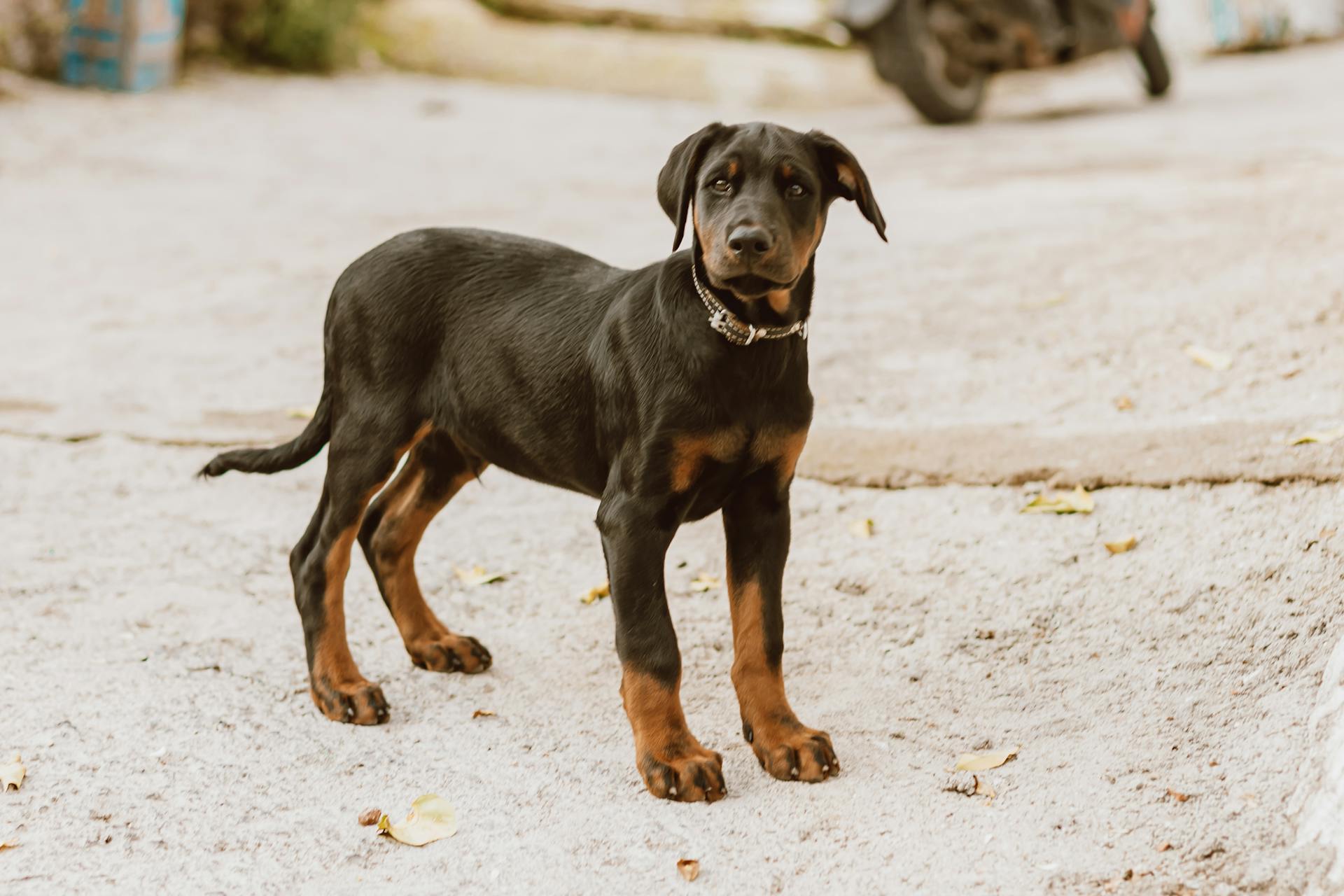
Operant conditioning dog training is a powerful approach that helps you shape your dog's behavior by associating actions with consequences. This type of training is based on the idea that behavior is a result of its consequences.
The key to operant conditioning is understanding the four quadrants of reinforcement, which are positive reinforcement, negative reinforcement, positive punishment, and negative punishment. Positive reinforcement is a favorite among dog trainers, as it increases the desired behavior by following it with a pleasing consequence.
By using positive reinforcement, you can encourage your dog to repeat desired behaviors, such as sitting or staying. For example, if you reward your dog with a treat every time they sit, they will learn to associate sitting with the treat and repeat the behavior.
The timing and consistency of reinforcement are crucial in operant conditioning. If you wait too long to reward your dog, they may not make the connection between the behavior and the consequence. Consistency is also key, as dogs thrive on routine and predictability.
Recommended read: Negative Reinforcement Dog Training
What Is Operant Conditioning?
Operant Conditioning is a powerful tool for teaching dogs what is expected of them. It's based on the idea that behaviours followed by rewards are likely to be repeated, while those followed by unpleasant outcomes are less likely to recur.
Professional dog trainers understand this concept, and it's essential to discuss it with them when engaging a training service. By rewarding desired behaviours and not rewarding undesired ones, we can guide our canine companions towards better habits.
Operant Conditioning creates associations between responses from the environment and the likelihood of a behavior being repeated. This can be either increased or decreased.
Reinforcers, which can be either positive or negative, increase the probability of a behavior being repeated. Punishers, on the other hand, decrease the likelihood of a behavior being repeated by weakening the behavior.
Here are some key terms to understand:
- Neutral operants: responses from the environment that neither increase nor decrease the probability of a behavior being repeated.
- Reinforcers: Responses from the environment that increase the probability of a behavior being repeated.
- Punishers: Responses from the environment that decrease the likelihood of a behavior being repeated.
By understanding Operant Conditioning, we can address behavioural challenges more effectively and compassionately, just like professional dog trainers do.
The 4 Quadrants of Operant Conditioning
Operant conditioning is a powerful tool for training dogs, and understanding the 4 quadrants is essential for getting the best results.
Positive reinforcement is a key part of operant conditioning, and it's about adding a pleasant stimulus to encourage a behavior. This can be as simple as giving a treat or praise when your dog does something good.
Negative reinforcement is another quadrant, and it's about removing an unpleasant stimulus to increase a behavior. This can be removing a leash or a collar when your dog behaves well.
Positive punishment is the opposite of positive reinforcement, and it's about adding an unpleasant stimulus to decrease a behavior. This is not a recommended approach, as it can create anxiety and stress in your dog.
Negative punishment is the final quadrant, and it's about removing a pleasant stimulus to reduce a behavior. This can be taking away a treat or toy when your dog misbehaves.
You might like: Dog Treat Training
Here are the 4 quadrants of operant conditioning in a quick reference list:
- Positive Reinforcement: Adding a pleasant stimulus to encourage a behavior.
- Negative Reinforcement: Removing an unpleasant stimulus to increase a behavior.
- Positive Punishment: Adding an unpleasant stimulus to decrease a behavior.
- Negative Punishment: Removing a pleasant stimulus to reduce a behavior.
Most trainers recommend leaning heavily on positive reinforcement with some negative punishment, as needed, to create favorable associations with training.
Positive Reinforcement
Positive reinforcement is a powerful tool in operant conditioning dog training. It's the means to increase a behavior, and a positive or appetitive stimulus is the reward for doing what you want.
Treats are an excellent motivator, and many dogs are eager to please and will respond to praise. Your goal is for your dog to make the connection and voluntary choice to do what's required to get the reward.
Positive reinforcement is the first quadrant of operant conditioning, and it's essential to use it effectively. According to the American Veterinary Society of Animal Behavior (AVSAB), reward-based learning offers the most advantages and least harm to the learner's welfare.
Here are some key points to keep in mind when using positive reinforcement:
- Treats are an excellent motivator, but you can also use praise and affection to reward your dog.
- It's essential to make the connection between the behavior and the reward clear to your dog.
- Every dog is different, and what motivates one dog may not motivate another.
Positive reinforcement creates a healthy training environment and provides valuable mental stimulation for your dog. Dogs are highly intelligent and need enrichment for a good quality of life, and operant conditioning can offer it.
Negative Reinforcement
Negative reinforcement is a powerful tool in operant conditioning dog training. It involves removing something uncomfortable to encourage a desired behavior.
For example, if you're training your dog to sit, you might pull their leash to an upward position, tightening the collar and creating minor discomfort, until they sit up. This is exactly what a trainer might do as described in Example 2.
The goal of negative reinforcement is to increase the likelihood of the desired behavior. By removing the uncomfortable stimulus, you're essentially saying "good job" to your dog.
Additional reading: Dog Training Positive Reinforcement
Balanced Training
Balanced training is a methodology that combines positive reinforcement with aversive, punishment-based training. This approach includes all four operant conditioning quadrants.
A balanced trainer might use treats to reward a dog for good behavior, but also use a choke chain to correct undesired behavior.
Positive punishment is a key component of balanced training, where a trainer adds something to a situation to get the result they want. This can be a loud noise or even a verbal command like "No!" in a low-pitched voice.
A fresh viewpoint: Negative Punishment Dog Training
Using a mix of positive reinforcement and punishment can create favorable associations with training, but be careful not to overfeed treats. Most dogs are highly motivated by food, so it's best to stick with a plan that incorporates rewards.
Balanced trainers often use a variety of tools, from clickers and body harnesses to aversive devices like choke, prong, and shock collars.
Dog Training Challenges
Dog training can be a challenging task, especially for new dog owners. One common challenge is the high likelihood of the dog getting distracted during training.
A dog's short attention span can make training sessions feel like a never-ending battle. This is because dogs have a natural instinct to follow their nose and investigate new sights and smells.
To overcome this challenge, dog owners can use high-value rewards and keep training sessions short. For example, a study found that dogs can learn faster with rewards that are more valuable to them, such as treats or praise.
A unique perspective: How Long Should a Dog Training Session Be
Dog Misbehaving
If your dog is still misbehaving, it might be that the punishment isn't potent enough to sway their behavior.
You might try a different sequence to see if you can find something more effective, as the choice of punishment isn't always a one-size-fits-all solution.
Positive punishment can be any action you add that affects your pet's behavior, such as making a loud noise, but it's essential to consider what works best for your dog.
Using a low-pitched, low-volume voice to signal your displeasure can be an effective form of positive punishment, but it's not always enough to change your dog's behavior.
Treats are an excellent motivator in positive reinforcement training, and many dogs are eager to please and will respond to praise, so it's worth experimenting with different rewards.
Recommended read: It's Your Choice Dog Training
Disadvantages
Using operant conditioning can be tricky, and some methods are more effective than others. Most experts agree that positive reinforcement is the most valuable approach.
Dogs learn equally through all four quadrants, but using them all equally isn't recommended. This can lead to confusion and make training more difficult.
Creating negative associations with behavior can discourage a dog from wanting to learn, making it harder to train them.
Frequently Asked Questions
What are the 5 golden rules of dog training?
Follow these 5 essential principles: go at your dog's pace, make rewards meaningful, set them up for success, prioritize consistency and patience, and never use punishment. By following these guidelines, you'll be well on your way to effective and stress-free dog training
Sources
- https://petcoach.sg/operant-conditioning-a-comprehensive-guide-for-dog-training/
- https://www.dogster.com/lifestyle/4-quadrants-of-operant-conditioning
- https://www.petmd.com/dog/training/balanced-dog-training-vs-positive-reinforcement
- https://www.caninescholars.com/learning-principles/operant-conditioning/
- https://www4.uwsp.edu/psych/dog/la/DrP2.htm
Featured Images: pexels.com


